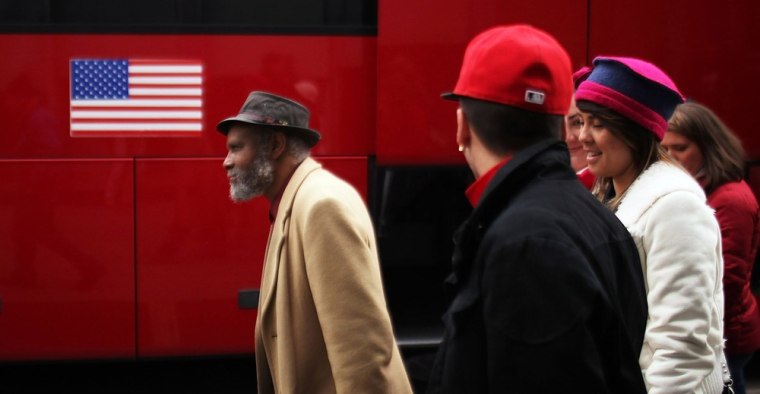Women still outlive men, but the gender gap among U.S. seniors is narrowing.
New 2010 census figures, released Thursday, show men are narrowing the female population advantage, primarily in the 65-plus age group. It signals a shift in the social dynamics of a country in which longevity, widowhood and health care for seniors often have been seen as issues more important to women.
Figures also show the Hispanic population growing four times faster than the total U.S. population.
In all, the numbers highlight a nation that is rapidly aging even as Congress debates cuts in Medicare, an issue with ramifications for the growing ranks of older men.
"We know in the past because of women's longer life expectancy, women put more emphasis on health care issues because they lived to an older age and often had to rely on the pensions of their husbands," said Jen'nan G. Read, an associate professor of sociology and global health at Duke University.
"I would expect men to become more aware and involved in health care now that they may be affected in the same way as women," she said.
Over the past decade, the number of men in the U.S. increased by 9.9 percent, faster than the 9.5 percent growth rate for women. As a result, women outnumbered men by just 5.18 million, compared with 2000, when there were 5.3 million more women than men.
"If current trends continue, men's life expectancy will approach that of women in the next few decades, creating more of a gender balance in the oldest age groups," said Mark Mather, an associate vice president of the Population Reference Bureau. "This has wide implications for family relationships in old age and caretaking, with more potential partners for older women."
The latest census figures come amid a graying baby boomer demographic of 78 million people — now between the ages of 46 and 65 and looking ahead to retirement — who will have a major voice in the 2012 elections as federal spending and the spiraling costs of Medicare rise to the forefront.
New census numbers show:
- The male-female ratio in the U.S. increased to 96.7 from 96.3 in 2000, reflecting the narrowing of the female advantage in overall population. (A score of 100 signifies equal numbers of men and women; a male-female ratio of 95, for example, would mean there are 95 men for every 100 women in the population.) There hasn't been such a sustained resurgence in the U.S. male population since 1910, when medical advances started to increase women's life expectancies by reducing deaths during pregnancy.
- Broken down by subgroups, men were more numerous than women among those 34 and younger as more boys than girls tend to be born.
- The 45-plus age group grew 25.6 percent in the U.S. since 2000 as baby boomers shifted into that category. That is compared with 1.4 percent for the under-45 group. Twenty-eight states showed numerical declines in the under-45 population, and all but 129 of the nation's 3,141 counties had increases in median age. Aging was most prominent in the Northeast and Midwest, where there are relatively fewer Hispanic immigrants, who tend to be younger.
- The median age rose to 37.2, up from 35.3 in 2000. Among the voting-age population, the 45-plus age group now makes up a majority at 51.9 percent, up from 42 percent in 1990.
- The District of Columbia, Rhode Island, Maryland, Massachusetts and New York had the largest shares of women. On the other end of the scale, Alaska, Wyoming, North Dakota and Nevada had higher male proportions, due partly to mining or construction industries that drew new workers.
- Seven states now have a median age of 40 or older. Maine has the oldest residents at 42.7 years, followed by Vermont, West Virginia, New Hampshire, Florida, Pennsylvania and Connecticut. Utah was youngest, with a median age of 29.2. Roughly 1,679 U.S. counties, or more than half, had median ages over 40; that's compared with 733, or less than one-fourth of counties, in 2000.
- Mexicans increased by 11.2 million to make up 63 percent of all Hispanics in the U.S., up 4.5 percentage points from 2000. They were the fastest-growing Hispanic subgroup, adding to their shares in all but three states (New Hampshire, Georgia and North Carolina). Arizona now has the third-largest Mexican population, behind California and Texas, after surpassing Illinois.
- The share of U.S. households with married couples fell to 48.4 percent, down from 51.7 percent in 2000. It was the first time the number dropped below 50 percent. In 1950, married couples made up 77 percent of households. Eighteen states last year showed declines in married couple households, while 41 states had drops in households containing married couples with children.
- People from India were the fastest-growing Asian subgroup, adding 1.2 million to make up 19.4 percent of all Asians. That's up 3 percentage points from 2000, although they still trailed Chinese, who have a 22.8 percent share. Virginia moved past Pennsylvania, Maryland and Michigan to post the seventh-largest Indian population, after California, New York, New Jersey, Texas, Illinois and Florida.
